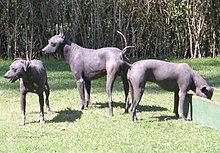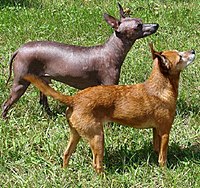Xoloitzcuintle: Difference between revisions
m →Appearance: formatting fix |
No edit summary |
||
| Line 27: | Line 27: | ||
<!-- End Infobox Dogbreed info. Article Begins Here --> |
<!-- End Infobox Dogbreed info. Article Begins Here --> |
||
The '''Mexican Hairless Dog''' is a rare, hairless [[breed]] of [[dog]] whose size varies greatly. It is also known as '''Xoloitzcuintli''' or '''Xoloitzcuintle''' (in English {{pronEng|ʃoʊloʊiːtskwiːntli}} ''show-low-eats-quint-lee''), or Mexican Hairless. Most owners of this dog call them "Xolos" .{{Fact|date=August 2007}} |
The '''Mexican Hairless Dog''' is a rare, hairless [[breed]] of [[dog]] whose size varies greatly. It is also known as '''Xoloitzcuintli''' or '''Xoloitzcuintle''' (in English {{pronEng|ʃoʊloʊiːtskwiːntli}} ''show-low-eats-quint-lee''), or Mexican Hairless. Not to be confused with the [[Peruvian Hairless Dog]]. Most owners of this dog call them "Xolos" .{{Fact|date=August 2007}} |
||
==Description== |
==Description== |
||
Revision as of 15:43, 3 June 2008
| Xoloitzcuintli | |||||||||
|---|---|---|---|---|---|---|---|---|---|
 Group of three Mexican Hairless Dogs | |||||||||
| Other names | Xoloitzcuintli Xoloitzcuintle Xoloitzquintle | ||||||||
| Common nicknames | Xolo AKCgroup - Miscellaneous | ||||||||
| Origin | |||||||||
| |||||||||
| Dog (domestic dog) | |||||||||
The Mexican Hairless Dog is a rare, hairless breed of dog whose size varies greatly. It is also known as Xoloitzcuintli or Xoloitzcuintle (in English Template:PronEng show-low-eats-quint-lee), or Mexican Hairless. Not to be confused with the Peruvian Hairless Dog. Most owners of this dog call them "Xolos" .[citation needed]
Description
Appearance
The breed ranges in size from about 10 pounds/4 kg to 50 pounds/20 kg. Contrary to popular myth, the breed does not have a higher than normal body temperature, does not sweat through its skin and contact with a Xolo cannot heal injuries or illness. These myths are based in the breed's traditional ceremonial use.
Similar in appearance to a Pharaoh Hound, with a sleek body, almond-shaped eyes, large bat-like ears, and a long neck, the Xolo is notable for its dominant trait of hairlessness. The dominant hairless trait originated in this breed as a spontaneous mutation thousands of years ago. The recessive expression of the trait will produce a coated variety, which is genetically inseparable from the hairless. Most litters contain both hairless and coated puppies. The coated variety, covered with a short, flat dense coat represents the original form of the dog, prior to the occurance of the spontaneous hairless mutation.[1] The hairless variety is completely hairless on the body. Some dogs exhibit a few short hairs on the top of the head, the toes and tip of the tail. Most hairless dogs are black or blue in color. According to standard genetic ratios, one out of every four puppies should be born coated.
History
The Xolo is native to Mexico, Central and South America and the Caribbean. Archeolgical evidence shows that the breed existed in the New World for more than 3,500 years. Most likely, early forerunners of the Xolo originated as spontaneous hairless mutations of indiginous New World dogs. Hairlessness may have offered a survival advantage in tropical regions. Their value in ancient Indian cultures is evidenced by their frequent appearance in the art and artifacts produced by the Colima, Aztec and Toltec civilizations in Mexico.
Xolos were considered sacred dogs by the Aztecs because they believed the dogs were needed by their masters’ souls to help them safely through the underworld. According to Aztec mythology, the god Xolotl made the Xoloitzcuintle from a sliver of the Bone of Life from which all man was made. Xolotl gave this gift to Man with the instruction to guard it with his life and in exchange it would guide Man through the dangers of Mictlan, the world of Death, towards the Evening Star in the Heavens. The Aztecs also raised the breed for their meat. 16th Century Spanish accounts tell of large numbers of dogs being served at banquets.[2]
When Columbus arrived in the Caribbean in 1492 his journal entries noted the presence of strange hairless dogs. Subsequently, Xolos were transported back to Europe.
Even today many people in Mexico believe this breed to have healing qualities. Some cultures ate the meat of the Xoloitzcuintli for ritual or medicinal purposes, and the meat may still be found for sale in some parts of rural Mexico.[citation needed]
Xolos were among the first breeds recorded by the American Kennel Club. A Mexican dog named Mee Too made breed history as the first AKC registered Xolo in 1887. Chinito Junior, bred and owned by Valetska Radtke of NYC became the breed's first and only AKC champion to date. He earned his title on October 19, 1940.
In 1959 the Xolo was dropped from the AKC studbook due to the breed's scarcity and perceived extinction.
The Xoloitzcuintli Club of America was founded in October 1986 to regain AKC recogntion for the breed. On May 13, 2008 AKC voted to readmit the breed to its Miscellaneous Class starting January 1, 2009.
The XCA is the official parent club for the breed, founded on October 26, 1986 for the purpose of regaining AKC recognition for the Xoloitzcuintli. The founding members voted unanimously to recognize all three sizes (toy, miniature and standard) and both varieties (hairless and coated) at our initial meeting. Since then, the XCA has compiled a studbook modeled on requirements for eventual AKC acceptance, held an annual independent specialty show, published a quarterly newsletter, The Xolo News, and maintained an active national rescue network, The Xolo Rescue League.
We have worked closely with AKC for two decades and AKC has maintained a comprehensive record of our club’s activities since that time. Our breed standard, constitution and by-laws have been approved and accepted by AKC. In 2000, the XCA registry was officially accepted by the Canadian Kennel Club as the American parent club for the breed. In 2005, the XCA studbook was turned over to the AKC FSS registry. At this time, XCA no longer accepts individual registrations. We encourage owners of all registerable Xolos to have their dogs registered with the AKC Foundation Stock Service. Contact AKC at www.akc.org for information regarding requirements, applications and fees. As of January 1, 2007, FSS registered Xolos are eligible to compete in AKC performance events.
Desite the Xolo's 3000 year history in Mexico the breed did not receive any official notice there until teh 1950s. The FCM, founded in 1940, was not prepared to declare the Xolo an official purebred at that time. According to breed historian, Norman Pelham Wright, author of The Enigma of the Xoloitzcuintli Xolos began to turn up at Mexican dog shows in the late 1940s. While it was recognized that these were indiginous specimens of a native breed, interest in them was minimal at that time. Information was scare and no standard existed by which to judge them. Within a decade the FCM realized that the breed would be extinct if drastic action was not taken to save it. This led to the widely pubicized Xolo Expedition of 1954. With the official sanction of FCM, Wright and a team of Mexican and British dog authorites set off to discover if any purebred Xolos still existed in remote areas of Mexico.
Eventually ten good Xolos were found and these dogs formed the foundation of Mexico's program to revive the breed. A committee headed by Wright authored the first official standard for the breed and on May 1, 1956 the Xolo was finally recognized in its native land.
Physical Characteristis of the Xolo
The Xolo is essentially a natural rather than a manmade breed, formed in response to natural rather than artificial selection. It is moderate in all aspects of its appearance, conveying, strenght, agility and elegance. Xolo body proportions are rectangular, slightly longer in total body length than the height measured at the highest point of the withers. The breed occurs naturally in two varieties, hairless and coated. Hairless Xolos are the dominant expression of the heterozygous Hh hairless trait. Coated Xolos (hh) are the recessive expression. Breeding hairless to coated or hairless to hairless will invariably produce pups of both varieties. Breeding coated to coated will only produce coated pups because they are recessive to the hairless trait and do not carry the dominant H gene.
Both varieties occur in all colors, solid, marked, splashed or spotted. The most common colors are various shades of black, blue, and red.
The breed occurs in a range of sizes, which breeders have standardized into Toy (ten to 13 inches in height, weighing approximately 12 pounds) Miniature (13 to 18 inches in height, weighing approximately 25 pounds) Standard (18 to 24 inches in height, weighing approximately 45 pounds)
Xolo Personality Profile
Adult Xolos are noted for their calm, demeanor but puppies can be quite noisy and unruly. The breed has definite primitive temperament traits and requires extensive socialization and training from eight weeks to a year of age. Xolo temperament can be compared to a typical Working breed, with strong guardian instincts. Their primitive heritage also encourages predatory behavior. Xolos can be escape artists, climbing and jumping fences to chase small animals. They are known to possess exceptional guard dog ability and will not back down from a fight. Therefore, basic obedience training and continued socialization is needed until adulthood.

References
The Xolo Handbook Published by the Xoloitzcuintli Club of America 1999 www.AKC.org
